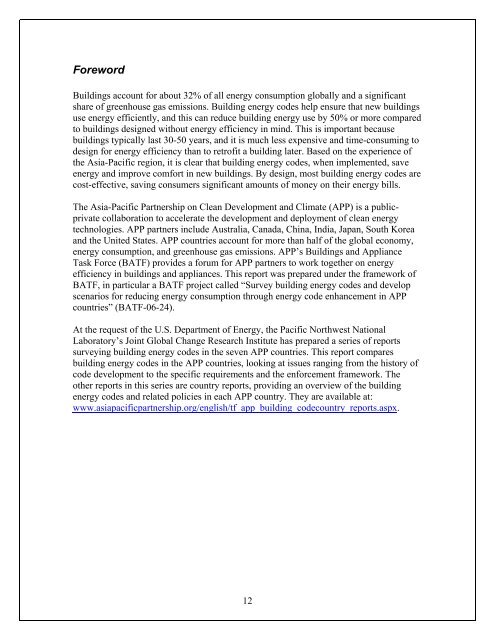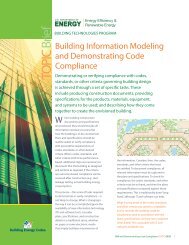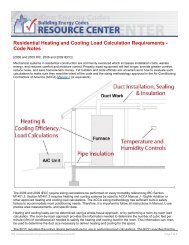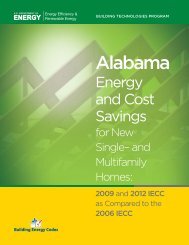ForewordBuild<strong>in</strong>gs account for about 32% of all energy consumption globally and a significantshare of greenhouse gas emissions. Build<strong>in</strong>g energy codes help ensure that new build<strong>in</strong>gsuse energy efficiently, and this can reduce build<strong>in</strong>g energy use by 50% or more comparedto build<strong>in</strong>gs designed without energy efficiency <strong>in</strong> m<strong>in</strong>d. This is important becausebuild<strong>in</strong>gs typically last 30-50 years, and it is much less expensive and time-consum<strong>in</strong>g todesign for energy efficiency than to retrofit a build<strong>in</strong>g later. Based on <strong>the</strong> experience of<strong>the</strong> Asia-Pacific region, it is clear that build<strong>in</strong>g energy codes, when implemented, saveenergy and improve comfort <strong>in</strong> new build<strong>in</strong>gs. By design, most build<strong>in</strong>g energy codes arecost-effective, sav<strong>in</strong>g consumers significant amounts of money on <strong>the</strong>ir energy bills.The Asia-Pacific Partnership on Clean Development and Climate (APP) is a publicprivatecollaboration to accelerate <strong>the</strong> development and deployment of clean energytechnologies. APP partners <strong>in</strong>clude Australia, Canada, Ch<strong>in</strong>a, India, Japan, South Koreaand <strong>the</strong> United States. APP countries account for more than half of <strong>the</strong> global economy,energy consumption, and greenhouse gas emissions. APP’s Build<strong>in</strong>gs and ApplianceTask Force (BATF) provides a forum for APP partners to work toge<strong>the</strong>r on energyefficiency <strong>in</strong> build<strong>in</strong>gs and appliances. This report was prepared under <strong>the</strong> framework ofBATF, <strong>in</strong> particular a BATF project called “Survey build<strong>in</strong>g energy codes and developscenarios for reduc<strong>in</strong>g energy consumption through energy code enhancement <strong>in</strong> APPcountries” (BATF-06-24).At <strong>the</strong> request of <strong>the</strong> U.S. Department of <strong>Energy</strong>, <strong>the</strong> Pacific Northwest NationalLaboratory’s Jo<strong>in</strong>t Global Change Research Institute has prepared a series of reportssurvey<strong>in</strong>g build<strong>in</strong>g energy codes <strong>in</strong> <strong>the</strong> seven APP countries. This report comparesbuild<strong>in</strong>g energy codes <strong>in</strong> <strong>the</strong> APP countries, look<strong>in</strong>g at issues rang<strong>in</strong>g from <strong>the</strong> history ofcode development to <strong>the</strong> specific requirements and <strong>the</strong> enforcement framework. Theo<strong>the</strong>r reports <strong>in</strong> this series are country reports, provid<strong>in</strong>g an overview of <strong>the</strong> build<strong>in</strong>genergy codes and related policies <strong>in</strong> each APP country. They are available at:www.asiapacificpartnership.org/english/tf_app_build<strong>in</strong>g_codecountry_reports.aspx.12
AcknowledgementsThis report owes its existence to <strong>the</strong> Asia-Pacific Partnership on Clean Development andClimate. We would like to thank all <strong>the</strong> APP partner countries and experts whocollaborated on this project. We are particularly grateful to Dr. Seung-Eon Lee at <strong>the</strong>Korean Institute of Construction Technology for his oversight of <strong>the</strong> APP project underwhich this report was prepared (BATF 06-24). We would also like to thank MarkG<strong>in</strong>sberg, Jean Boul<strong>in</strong> and Marc LaFrance from <strong>the</strong> U.S. Department of <strong>Energy</strong> for <strong>the</strong>irleadership and f<strong>in</strong>ancial support of this work.Diana Shankle, manager of <strong>the</strong> PNNL Build<strong>in</strong>g <strong>Energy</strong> Codes Program, has providedmoral and <strong>in</strong>tellectual support for this project. Mark Halverson reviewed this report andRosal<strong>in</strong>d Schrempf edited it. We would also like to express our gratitude to several o<strong>the</strong>r<strong>in</strong>dividuals who supported or participated <strong>in</strong> <strong>the</strong> APP build<strong>in</strong>g energy code assessment <strong>in</strong>various capacities <strong>in</strong>clud<strong>in</strong>g Anurag Bajpai, Haewon Chon, Jim Clark, Julie Claydon,Suzanne Deschennes, François Dubrous, Joe Huang, Satish Kumar, Ravi Kapoor, KayKill<strong>in</strong>gstad, Wei Jiang, Michel Lamanque, Paulette Land, Siwei Lang, Elly Lee, HaiyanL<strong>in</strong>, B<strong>in</strong>g Liu, Elizabeth Malone, Bip<strong>in</strong> Shah, Rob<strong>in</strong> S<strong>in</strong>ha, Sriram Somasundaram, BoSong, Kim Swier<strong>in</strong>ga, Tomoko Tagaki, X<strong>in</strong>chun (Steven) Wang, Xiaojiao Zhu andseveral anonymous reviewers from <strong>the</strong> APP countries.13
- Page 1 and 2: PNNL-122267Shaping the Energy Effic
- Page 3: Shaping the Energy Efficiency in Ne
- Page 6 and 7: efficient air conditioning system,
- Page 8 and 9: ContentsForeword ..................
- Page 10 and 11: List of TablesTable 1 GDP, Primary
- Page 14 and 15: 1 Introduction and Background1.1 Im
- Page 16 and 17: esidential buildings in 2006, with
- Page 18 and 19: JAP 1. Criteria for Clients on the
- Page 20 and 21: can significantly increase energy d
- Page 22 and 23: f) South Korea’s building energy
- Page 24 and 25: 2.1 AustraliaIn the past, Australia
- Page 26 and 27: small cities will be pilot of such
- Page 28 and 29: (DCGREUH) issued by the Ministry of
- Page 30 and 31: according to the current codes. Thi
- Page 32 and 33: Table 7 Structural Comparison of Bu
- Page 34 and 35: 3.3 Building EnvelopeKey Findings A
- Page 36 and 37: JAPCCREUH1999KORBDCES2008USAASHRAE9
- Page 38 and 39: This study selects the midpoint sco
- Page 40 and 41: MiamiUSA0.36(Insulationabove deck)t
- Page 42 and 43: Six countries have jurisdictions in
- Page 44 and 45: thermal requirements for roofs, flo
- Page 46 and 47: Figure 6 Maximum U-factors in Resid
- Page 48 and 49: Table 16 HVAC in Japan’s Building
- Page 50 and 51: ItemsService water heating refers t
- Page 52 and 53: Water conservation Canada has manda
- Page 54 and 55: practice (MNECB 1997). India sets m
- Page 56 and 57: Canada and India adopt compliance p
- Page 58 and 59: Japan only supervises the building
- Page 60 and 61: 4.2 Testing and RatingKey Findings
- Page 62 and 63:
Other commonly used tools among APP
- Page 64 and 65:
CAN 55MNECH1997CHNINDECBCJAPCanadia
- Page 66 and 67:
and local jurisdiction contact info
- Page 68 and 69:
certifying third-party verifiers or
- Page 70 and 71:
Point of ControlIncentives for Comp
- Page 72 and 73:
Point of ControlIncentives for Comp
- Page 74 and 75:
AUS,continuedCANTesting Agencies an
- Page 76 and 77:
CAN,continuedCHNTesting Agencies an
- Page 78 and 79:
Testing Agencies and Certification
- Page 80 and 81:
USA,continuedTesting Agencies and C
- Page 82 and 83:
Appendix C - Compliance SoftwareAUS
- Page 84 and 85:
CANMNECB1997,continuedSoftwareMetho
- Page 86 and 87:
USAIECC 2006,continuedSoftwareMetho
- Page 88 and 89:
AUSBCA 2007,continuedCANMNECB1997CA
- Page 90 and 91:
JAP,ContinuedKORUSAASHRAE90.1-2007T
- Page 92 and 93:
AcronymsAPPAS/NZSASHRAEAUSBATFBCABD
- Page 94 and 95:
ReferencesABCB (Australian Building
- Page 96 and 97:
IEA (International Energy Agency).
- Page 98:
OEE. 2008. Energy Use Data Handbook
















